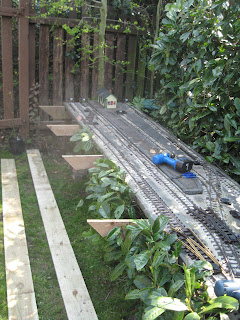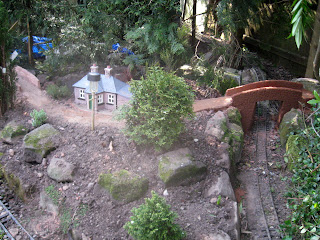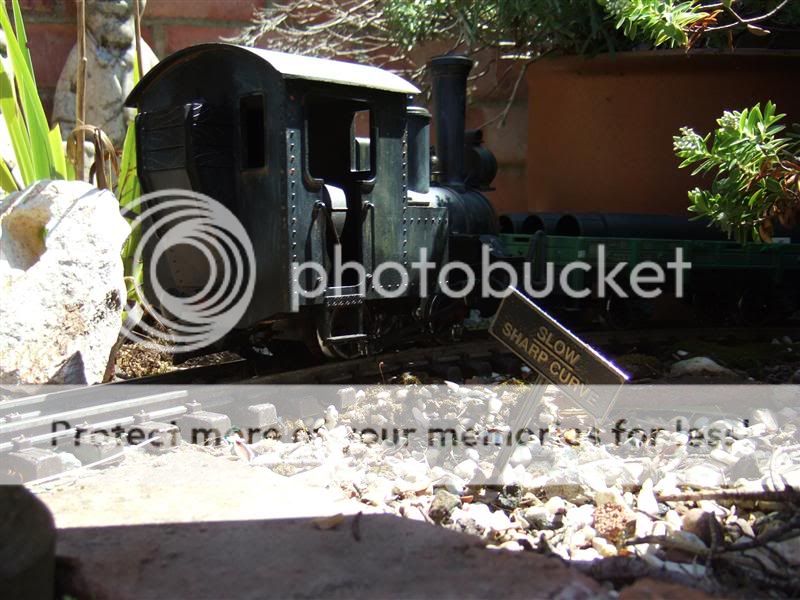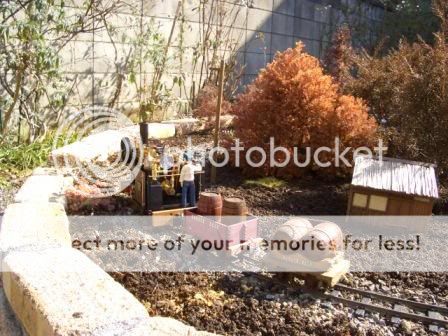At least three years before I laid my first length of track in the garden, I started planning and gathering as much information as I could about how others had done want I wanted to do. I tried to learn from their experience. These links provide a flavour of the sort of websites I visited, the books I read and the videos (and later DVDs) I watched.
I owe a great deal to those who helped, inspired and guided me. In the end, though, I found the best way to learn is to get stuck in and have a go. No matter how much I learned from others, there was nothing like making mistakes and learning from them, which I'm still doing.....
This is by no means a definitive list and will be added to as I come across more sources.
Societies etc.
G Scale Society
The society for those modelling in G Scale. Plenty of information, links and opportunities to join in events
The Association of 16mm Narrow Gauge Modellers
Information, ideas and opportunities to participate. For 32 mm and 45mm gauge modellers.
Exhibitions and Events
The two most significant events in the Garden Railways calendar in England are those currently held at Llanfair Caerenion and Stoneleigh.
Welshpool and Llanfair Steam Gala
The W&LLR Steam Gala is usually held during the first weekend of September and includes a large Garden Railway Fair with model railways on show and most of the garden railway suppliers in evidence. Plenty of opportunity to see what's on offer, discuss problems and share experiences withlike-minded people. Search the W&LLR website for details.
The National Garden Railway Show
This event, organised by the Association of 16mm Narrow Gauge Modellers is usually held at the start of April at Stoneleigh Park near Kenilworth. Again, plenty of ideas and inspiration on show for those wanting to find out more about garden railways. There is usually a link to details of the event on the 16mm Society's website.
Books - Garden Railways
Some of the books which inspired and informed my interest in garden railways are a bit dated now but nevertheless provide some very useful ideas. There are a couple of other titles which are on my Amazon wishlist which I have heard are very informative. I am always interested in finding out the views of others in tackling the problems and issues which I've had to face.
This was the first book I bought on garden railways. I found it useful as an introductory guide but felt I needed something which was more practical. The video which accompanies the book I found to be inspiring - both in terms of providing me with ideas and also helping me decide which type of railway I wanted to build. I certainly wanted a UK based railway but was concerned that SM32 seemed to rely on steam or battery power. Coming from an 00, 00n3 and 009 background I was more comfortable with track power (and ready-to-run stock).

Having subsribed to Railway Modeller since 1965, I was a devotee of Cyril Freezer - particularly his track plans. Also, it was the articles in RM written by Peter Denny and Don Neale about their garden railways which first fired my enthusiasm. It seemed natural, therefore, to invest in CJ's Garden Railway Manual, which I've probably read four or five times from cover to cover and dipped into many times. It's well detailed and very practical - but there's very little on planting out the garden (which is my area of weakness).
Peter Jones's books lives up to its name. it is highly practical. I've only had this copy for about the past two years, but I've always found Peter's articles to be interesing to read and well informed - based very much on his slightly idiosyncratic first hand experience in constructing and running the Compton Down Railway over many years.
His untimely death was a great loss to the world of garden railway modelling.
Books - The real thing
Inevitably, what I model has to be informed by the real thing. Although my prototype is hypothetical, I have tried to base its supposed origins and its operational practices on narrow gauge lines which are similar to mine. The greatest influence has been from the Southwold Railway and from the Welshpool and Llanfair. The Southwold was a 3' narrow gauge railway based in the East of England, serving a seaside town and a rural community, while the Welshpool and Llanfair was a 2'6" gauge line on the English/Welsh border serving a rural community. The books on these railways which I've found useful are:
This Middleton Press book provides plenty of photographic information about the line from its construction through to the present day. There are maps and plans of stations together with some useful background information on the operation of the line and some of its rolling stock.
This book from Rail Romances is a far more comprehensive work detailing the history of the railway and providing more detail and scale drawings of the rolling stock and locos.
This Middleton Press book is the most detailed on the Southwold Railway and contains plenty of photographic detail about the railway together with some background on the history and scale drawings of the locos, coaches and rolling stock.
In addition, I am always accumulating books and information about other narrow gauge railways. A couple of more generalised books on narrow gauge railways in the Bristsh Isles which I have found useful include:
I picked up this comprehensive guide to the narrow gauge railways of Britain and Ireland very cheaply at the Narrow Gauge Railway Show which is held annually in Telford. It provides a well researched and highly comprehensive overview of the narrow gauge passenger carrying railways in the UK. It also mentions some of the more well known industrial narrow gauge railways such as the Bowater Paper Mills Railway and the Woolwich Arsenal Railway.
This volume contains plenty of photos and background information about many of the narrow gauge railways in the UK which complements other volumes. There is a balance of passenger carrying, industrial and miniature railways. Inevitably, it is selective about what has been included.
Magazines
Of course these provide plenty of information and advice for those wanting to start or to improve. I tend to buy back issues whenever I come across them and then tear out the articles which I think might be useful in the future.
Garden Railways Magazine
In addition to publishing articles, Garden Railways provides a range of free information and also sells compilations of related articles on useful topics such as tracklaying, making buildings and painting. Published in the USA, the magazine focuses mainly on US models but does include UK and Europe information from time to time.
Garden Rail
Garden Rail is published in the UK and hence is more geared to models and modelling of British and European origins. I actually have an online subscription which means my copy is accessed via the internet and can search through back issues for particular information.
16mm Today
This magazine is produced by the 16mm Association and comes as part of the subscription. Again, it has a UK-centric focus and features articles on all manner of topics from constructing live steam locos from scratch to making lineside fences out of kindling wood.
Other people's railways
Visiting others' railways is always a source of inspiration which is why joining one of the societies is invaluable. However, if this is not feasible, or desirable, a lot can be learned by visiting virtually - either by accessing websites (such as this one) or watching video clips.
Some of the websites of others' railways which I've found most useful and inspirational are:
Bekonscot Model Village
Probably the most inspirational garden railway and and model landscape in the country. An essential day out for any aspiring garden railway modeller. Video of a driver's eye view of the whole line (10 scale miles)
St Andrews Island Line
 A 7/8" (SE) scale railway on 45mm gauge track. Plenty of imaginative and well executed
A 7/8" (SE) scale railway on 45mm gauge track. Plenty of imaginative and well executed
kit-bashing and scratch-building on this delightful little railway. As an artist, the builder has a well developed eye for creating a really attractive representation of an estate railway.
The Evensford and Midland Railway
Nicely presented website with a clear overview of the garden railway and its construction techniques. The quality of photos and videos is very good. 45mm inspired by British NG practices.
The Scampington & Chipside Railway
A continental 45mm gauge garden railway based in Hampshire. Plenty of pictures and background information, including some articles on weathering stock and remodelling and painting figures.
The Takasaki Light Railway
This 32mm gauge garden railway is based in Japan but is UK inspired and mostly scratch built. Some interesting and useful articles.
The Haggerleases Light Railway
Another UK-based 32mm gauge railway with some interesting articles - particularly on how to make a simple turntable and point rodding. The website has not been updated since 2006, so maybe construction on the railway has ceased.
The Moreton Pits Light Railway
A 32mm gauge garden railway with a range of information, including construction of a loco from a Locolines kit.
The Westwood and Loscoe Light Railway
A 45mm gauge garden railway based on UK practice. Some interesting stock including locos constructed from Locolines kits.
The Stanworth Heath Light Railway
 Another 45mm gauge railway set in the UK with a range of LGB and other stock. Seems
Another 45mm gauge railway set in the UK with a range of LGB and other stock. Seems
to be in its 7th incarnation, each version aiming to improve operation and realism.
East Appledore Light Railway
Blog of a 45mm gauge railway set (and located) in Devon. Some similarities to Peckforton Railway in terms of stock and setting, though more creatively executed. Some nicely built scratchbuilt rolling stock, a well painted and lined GRS Peckett and some impressive scratchbuilt signals.
The Sandstone and Termite Railway
A really impressive 45mm garden railway located in Australia. All the stock and the track has been scratchbuilt with radio control via car remote control key fobs (though now Greg's gone over to 2.4Ghz systems). Interesting layout with plenty of handy tips and ideas for beginners and experienced modellers alike.
JJW Trains
Another blog dedicated to model railways with suggestions for planning and construction.
Smoky Timber Logging Co.
A blog (same author as above) describing the ongoing development of a G Scale USA based railroad
The Mid Derbyshire Light Railway
A fictional 32mm gauge railway set in a real location in Derbyshire. Useful articles on construction and rolling stock. Has been featured in Railway Modeller and Garden Rail. The line has now, unfortunately, been dismantled owing to theft of track and vandalism on two separate occasions.
Wetton Gooey Light Railway
This 45mm narrow gauge railway, based loosely on the Welshpool & Llanfair shows just waht can be achieved in a small space with a lot of imagination and a fair degree of skill. Mel has even managed to incorporate a Gauge 3 standard gauge interchange station.
The Trawbreaga Bay Light Railway
A fictional 45mm gauge garden railway set in County Donegal. Some very impressive rolling stock and general information about construction.
 The Light Railway Project
The Light Railway Project
A blog describing the development of a 45mm narrow gauge railway in Oregon following UK-based practices.
_________________________________
Videos
I found watching videos of garden railways to be particularly helpful. Some are commercially produced but others are made by enthusiasts for fellow enthusiasts such as the Railway Magic videos produced by John Preston. These and others can be bought from garden railway suppliers such as
Glendale Junction.
Garden Trains (on Film)
A really useful and interesting archive of garden railway films and other useful videos for the garden railway modeller
There are plenty of video clips of garden railways on
Youtube. A search for Garden Railways will result in around 1000 videos. The
Railway World programmes are particularly interesting.
________________________________
Websites (non commercial)
Websites which provide information can provide useful ideas. Here are a few...........
The Garden Railway Club
UK based and full of useful tips and articles from Garden Railway modellers wanting to share their experiences with others.
Family Garden Trains
A comprehensive website full of information and ideas - which has been in existence since 1996 - so has a good pedigree.
4largescale.com
A US site with links to websites on larege scale modelling.
Garden Railway Realism
A wiki for those interested in enhancing the realism of garden railway modelling,
Large Scale Tech Tips
A US based site with a wealth of information about all aspects of large scale modelling.
_________________________________
Commercial websites
In addition to trying to entice you to part with your hard-earned cash, many commercial sites provide some really useful information. The world of garden railway enthusiasts is still small enough for a close knit community to have developed - most suppliers are keen modellers themselves.
Railmags - 16mm supplier links
A list of suppliers for 16mm scale products compiled by Andy and Suzanne Bradley
Brandbright
As well as manufacturing live steam locos, Brandbright produce a range of well engineered rolling stock kits and parts for the modeller.
Dragon G-Scale
A good range of products at reasonable prices.
Garden Railway Centres
In addition to the shop, there is information for beginners and a gallery of customers' railways. The shop covers many of the commercial products and has a secondhand section.
Garden Railway Specialists
Not only supply ready to run models from the major manufacturers but also a range of their own kits, models and parts for the garden railway enthusiast. In addition, they have a forum where modellers can seek guidance and sharte experiences.
Glendale Junction
A range of products for the garden railway modeller including secondhand items. A good source of information about latest developments and events.
IP Engineering
A range of models and kits for large scale modelling.
Jim's Models
Rolling stock and lineside kits and models, including painted Busybody figures.
Modeltown
All sorts of lineside and detailing kits and bits.
Perfect World Models
Rolling stock and loco kits.
PPS Steam Models
Spares for steam locos plus UK based rolling stock kits and bits.
Scottish Garden Railways
Garden railway products for sale plus plenty of information, guidance and examples of other people's railways in the 'Signal Box' section.
Worsley Works
Kits for large scale modelling - mostly UK based prototypes
 A couple of new developments since the last report. Firstly I've widened the boards supporting Beeston Market Station and added four new sidings; two for goods and two for a loco shed (see - How I extended the extension).
A couple of new developments since the last report. Firstly I've widened the boards supporting Beeston Market Station and added four new sidings; two for goods and two for a loco shed (see - How I extended the extension). While I was at it, I bought a plastic tarpaulin to cover the station when not in use. Because this area is overhung with trees it tends to remain damp and also accumulates a lot of muck from fallen leaves. I am hoping the tarp will alleviate this particularly when I come to add some of the finer details and embellishments.
While I was at it, I bought a plastic tarpaulin to cover the station when not in use. Because this area is overhung with trees it tends to remain damp and also accumulates a lot of muck from fallen leaves. I am hoping the tarp will alleviate this particularly when I come to add some of the finer details and embellishments. I've also fixed the signal box (made from a T&M Models* kit) in place at Beeston Market to indicate its status as the main station on the line.
I've also fixed the signal box (made from a T&M Models* kit) in place at Beeston Market to indicate its status as the main station on the line. The station building at Peckforton (also from T&M Models - see How I assembled the station buildings) has been fixed in place
The station building at Peckforton (also from T&M Models - see How I assembled the station buildings) has been fixed in place and picket fencing (from Garden Railway Services - GRS) has been added to the platform.
and picket fencing (from Garden Railway Services - GRS) has been added to the platform.
 Next on the list is to build a timber yard alongside the siding in the foreground of this shot and add name-boards, people, a cattle dock and all sorts of general clutter (porters' trolley, packing cases etc.).
Next on the list is to build a timber yard alongside the siding in the foreground of this shot and add name-boards, people, a cattle dock and all sorts of general clutter (porters' trolley, packing cases etc.).
















































